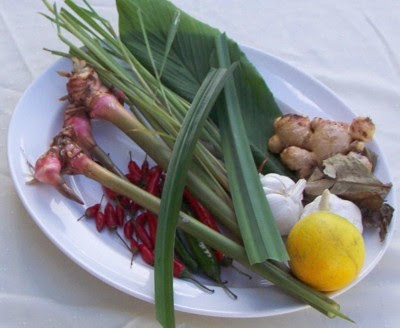Indonesian Ingredients

Even for the 30% of Indonesians lucky enough to own a refrigerator, it's a common practice to make a daily trip to the pasar (farmer's market) where only the freshest of ingredients can be selected for the next meal or two. Half thefun in going is the haggling that goes on for a price that satisfies both buyer and seller. There are lot of Indonesian ingredients that you can find. Indonesia is very rich of spices.
For the foreign visitor, the pasar offers a direct window into Indonesian community life. It's a place where you can interact with locals and practice your Indonesian immersed in astonishing variety of goods and services. In the traditional market, you can explore and get many Indonesian ingredients with cheaper price.
As you walk you will encounter everything from the gargantuan knobby nangka (jackfruit) to the formidably spiked and notoriously redolent durian fruit. Fragrant cooking leaves purify air left pungent by potent terasi (shrimp paste). Familiar enough European vegetables bask innocently alongside gnarled rhizomes and the luminous green "body snatcher" pods of petai. Women in batik sarongs sort through row upon row of wooden bins overflowing with waxy candle nuts, aromatic spices and endless piles of chilies.
In addition to stationary bins, free-lance hawkers roam the market with everything imaginable in tow. Some carry vessels of young coconut juice or balance brightly colored bottles of jamu (health potions) between the flexing ends of bamboo poles. If they don't have what you're looking for, you will eventually find it at one of the tiny food stalls peppered throughout the market. Everywhere people are offering delicious snacks to break up the shopping into manageable bites.
After experimenting this colorful Pageantry, the fluorescent glow of your local supermarket will never seem as grand. However many of Indonesia's essential ingredients and spices are available with just a little effort. What can't be found in the specialty section of a large supermarket is usually available fresh or frozen at Asian grocery stores. Dried, bottled and canned version of many Indonesian ingredients can also be located and ordered on internet.
Bookmark/share this article with others:For the foreign visitor, the pasar offers a direct window into Indonesian community life. It's a place where you can interact with locals and practice your Indonesian immersed in astonishing variety of goods and services. In the traditional market, you can explore and get many Indonesian ingredients with cheaper price.
As you walk you will encounter everything from the gargantuan knobby nangka (jackfruit) to the formidably spiked and notoriously redolent durian fruit. Fragrant cooking leaves purify air left pungent by potent terasi (shrimp paste). Familiar enough European vegetables bask innocently alongside gnarled rhizomes and the luminous green "body snatcher" pods of petai. Women in batik sarongs sort through row upon row of wooden bins overflowing with waxy candle nuts, aromatic spices and endless piles of chilies.
In addition to stationary bins, free-lance hawkers roam the market with everything imaginable in tow. Some carry vessels of young coconut juice or balance brightly colored bottles of jamu (health potions) between the flexing ends of bamboo poles. If they don't have what you're looking for, you will eventually find it at one of the tiny food stalls peppered throughout the market. Everywhere people are offering delicious snacks to break up the shopping into manageable bites.
After experimenting this colorful Pageantry, the fluorescent glow of your local supermarket will never seem as grand. However many of Indonesia's essential ingredients and spices are available with just a little effort. What can't be found in the specialty section of a large supermarket is usually available fresh or frozen at Asian grocery stores. Dried, bottled and canned version of many Indonesian ingredients can also be located and ordered on internet.

0 comments:
Post a Comment